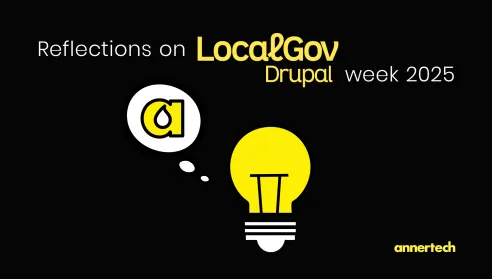LocalGov Drupal: Subsites vs microsites

Both subsites and microsites are available in the LocalGov Drupal ecosystem, but what’s the difference, and which one will best serve your needs? The short answer is: it depends on what you’re trying to achieve.
Council websites can be large, depending on the size of the council and the services it offers. And the best way to present information to the users can entail the separation of content.
This is one growing trend we’ve experienced with the councils that we work with – the need for subsites and microsites. There are lots of cases to be made for additional sites.
If there is a big event, for example a food festival or a road race, a council might decide to have a website dedicated specifically to this event. If the council has another department, for example a tourism department, it might want a website dedicated specifically to this department.
These additional websites could have council branding, they may be completely separate from the council website, or co-branded with a partner. But the big question is should they be microsites or subsites?
Microsites vs subsites: What’s the difference?
The main difference between microsites and subsites is where they “live” on the internet. A microsite is a small independent, focused website that is designed to serve a specific purpose or audience. A subsite, on the other hand, is a part of your main website and uses the main URL or address of the website at its root.
For example, an organisation might be hosting an event. If the event is small and the event doesn’t have much content, then the event content could be kept on the main website on a subpath of the main domain such as /our-amazing-event with all related content pages underneath that path. In this case, the event section of the website is a “section” or “subsite” of the main site.
However, if an organisation is hosting a large event, and the event could have lots of content – for example an agenda, biographies on all the speakers, information on the various presentations, information about the location and venue etc, it might decide to set up a standalone microsite, with its own separate domain.
Subsites are typically
- Sections within a main website, sharing the same top-level domain
- Integrated with the parent site's navigation, branding, and design system, perhaps with some colour or other minor variations
- Managed through the same CMS as the main website
- Focused on extending the main site's content with specialised information
Microsites are typically
- Standalone websites with their own domain or subdomain (microsite-name.gov.uk or microsite.council.gov.uk)
- Designed with distinct branding and navigation that may differ from the main corporate website
- Managed through a separate CMS from the main website
- Often built on separate platforms with independent hosting
Which is better, a microsite or a subsite?
This will depend on a council’s specific needs.
A subsite is better when:
- The content is shallow
- Brand consistency needs to be maintained
- The content is an extension of the main offerings
- The site needs integration with existing website functionality
- SEO authority must flow between sections
- Long-term maintenance is a priority
A microsite is better when:
- There is more content and the content is deeper
- The project has a distinct audience or unique purpose
- There is a need to experiment with new design approaches
- The content requires a focused, immersive experience

Thinking about a microsite for your next campaign?
Discover the pros and cons before you dive in.
Read the blogLocalGov Drupal and sub/microsites
LocalGov Drupal has solutions for both subsites and microsites.
- The LocalGov Drupal Subsites Extras extension
- The LocalGov Drupal Microsites Platform
1. LocalGov Drupal and subsites
Towards the end of 2022 LocalGov Drupal saw the launch of subsites support within the platform, but this was limited in nature. So a more flexible subsites solution was designed, with different theming and support for LocalGov Drupal content types like directories.
The LocalGov Drupal Subsites Extras extension allows councils to create menu-driven subsites with a different look and feel to their LocalGov Drupal website. The menu defines the structure of the subsite, and also lets councils use Drupal's standard menu blocks and tools to display the subsite's navigation and manage the hierarchy of the pages within it.
You can see a good example of Subsites Extras in use on Essex’s fostering website. Note the URL – www.essex.gov.uk/children-young-people-and-families/fostering – which clearly shows that it is a section of the main website, and once users have navigated to it they’ll see that it’s clearly integrated with the parent site's navigation, branding, and design system.
2. LocalGov Drupal and microsites
For microsites there is the standalone LocalGov Drupal Microsites platform. This is a separate product from the LocalGov Drupal platform and makes creating and maintaining multiple websites easier than ever.
It allows councils to operate an entire fleet of microsites from one easy-to-use platform that gives users oversight, improved governance and control of their entire digital estate.
The Love Essex website we developed for Essex County Council is an excellent example of a microsite. It is the official website of the Essex Waste Partnership – 12 district, city and borough councils in Essex and Essex County Council working together to ensure cost-efficient and sustainable waste management across the county.
Note the URL: https://www.loveessex.org. It is a standalone website with its own domain. It is also designed with its own distinct branding and navigation and is created specifically for this waste management partnership.
Conclusion
Both microsites and subsites offer real value to councils who are trying to manage large websites with varying volumes and types of content. Each has their own strengths which will dictate which is the best solution for each council’s individual use case.
Together, the LocalGov Drupal and LocalGov Drupal Microsites products offer councils a complete solution, providing them with the flexibility and functionality they need to manage their digital estate.

Are you looking to add microsites or subsites to your council website?
Annertech is a proud LocalGov Drupal partner, and we’d be delighted to talk to you about expanding your website’s needs.
Get in touch


